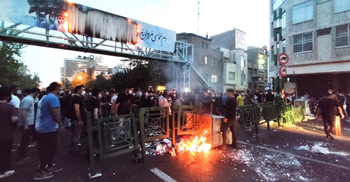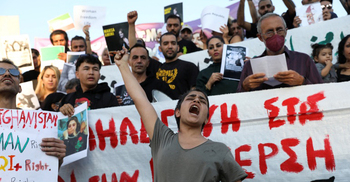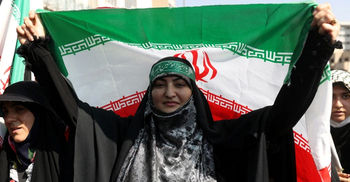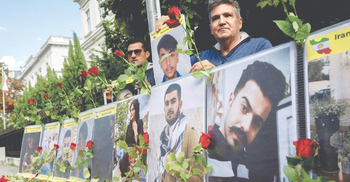Mahsa Amini: What we know after 11 days of protests in Iran
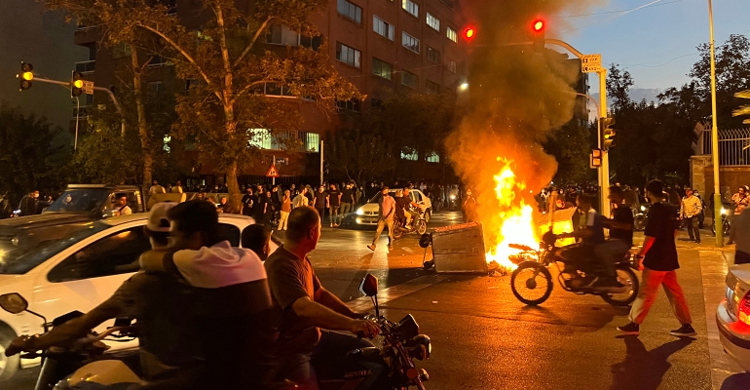
Protests that erupted in many parts of Iran following the death of a young woman, Mahsa Amini, entered their 11th day on Tuesday, even as authorities continued to restrict access to the internet.
The 22-year-old was arrested earlier this month in the capital, Tehran, by Iran’s so-called “morality police” for allegedly not following the country’s dress code for women. Authorities said she later had a stroke while in custody and died in a hospital on September 16, three days after falling into a coma.
Amini’s family, in interviews with local media, have rejected authorities’ claims that she suffered from pre-existing conditions and said she may have been beaten. A state investigation into the cause of her death is expected to turn up results within weeks.
In the meantime, protests that began in Amini’s hometown of Saqqez in Kurdistan province have since spread to most of Iran’s 31 provinces. Dozens of people are believed to have been killed and an unknown number arrested. The authorities have not released official figures yet.
Citing “security reasons”, authorities have imposed severe internet restrictions that ban access to social media and messaging platforms and become more limited from the afternoon.
But hundreds of clips of sporadic protests continue to come out daily, in which demonstrators can be heard chanting anti-establishment slogans. In some videos, women are seen burning their hijabs and cutting their hair.
The United States, the European Union and human rights organisations have condemned the use of violence against protesters. The US has also imposed sanctions on the morality police for alleged abuses and violence against women and demonstrators.
There have also been demonstrations outside Iran in support of the nearly-two week protests, with a number of international celebrities also expressing solidarity.
State response
Inside Iran, there have so far been two state-organised counter-demonstrations to express support for the establishment.
The authorities have denounced “riots” during which public property has been burned. They also say “anti-revolutionary” elements guided by foreign powers are driving these movements.
President Ebrahim Raisi and other top officials have met or spoken on the phone with the families of several police officers and members of the Basij paramilitary forces who have been killed during the protests. These officers also received state-backed funerals.
Meanwhile, the Islamic Revolutionary Guard Corps (IRGC) attacked positions in the Kurdish region of northern Iraq four times during the past few days, saying the target was “terrorist” groups that brought guns into the country to take advantage of the protests.
The elite force has also said secessionist elements have been arrested on Iranian soil and a bomb plot was defused in Tabriz, a city in northwestern Iran.
“We will hit anti-revolutionaries anywhere they are based and become a source of operations against the Islamic Republic and the nation of Iran,” Abbas Nilforushan, the force’s deputy for operations, said in an interview with state media published late on Tuesday.
Local media have reported how intelligence authorities are analysing CCTV camera footage in areas where there are protests to arrest “rioters”.
“There is not a big deal going on in Iran,” Foreign Minister Hossein Amirabdollahian told United States media outlet NPR in an interview published on Tuesday.
“There is not going to be regime change in Iran. Don’t play with the emotions of the Iranian people.”
Reactions and arrests
Two respected Muslim leaders have so far commented on the protests.
Grand Ayatollah Naser Makarem Shirazi and Grand Ayatollah Hossein Noori Hamedani said Iranians, especially the youth who have featured prominently in the protests, have a right to protest and officials must listen to them.
They warned, however, that protests must not be in such a way that “enemies” of the Islamic Republic can take advantage of, and religious tenets must not be violated during demonstrations.
At least two renowned Iranian celebrities have also been making headlines.
Ali Karimi, a former star player of the country’s national football team, has been regularly posting on his social media in support of the protests.
Karimi reportedly lives in the United Arab Emirates, so some state-affiliated media have mentioned the possibility of his arrest through Interpol for allegedly inciting protests. Officials have not commented.
There were reports that his properties have been confiscated, with images on Tuesday showing a luxury villa in Lavasan near Tehran being sealed by the judiciary. But the semi-official Fars news website said Karimi had liquidated or transferred his assets prior to leaving Iran.
Mehran Modiri, a comedian and television personality, has also posted a video online against the authorities’ response to the protests.
The semi-official Tasnim news website reported on Wednesday that Modiri was not in the country, without saying how he had left despite a judicial order that barred him from exiting.
There have been several high-profile arrests since the protests broke out.
Niloufar Hamedi, a reporter with the daily Shargh newspaper, one of the first to report on Amini’s hospitalisation and death, was arrested in her home in Tehran last week.
One of several journalists arrested, she is now in solitary confinement at the Evin prison, according to her husband Mohammad Hossein Ajorlou.
State-affiliated media reported late on Tuesday that Faezeh Hashemi, the daughter of late President Akbar Hashemi Rafsanjani, has been arrested by intelligence authorities for “inciting rioters to street protests in eastern Tehran”.
Hashemi, who has a history of making anti-establishment comments, had previously been barred from official political activity. Semi-official media reported she had also been arrested during previous street protests, without specifying when.
Source: Al Jazeera


